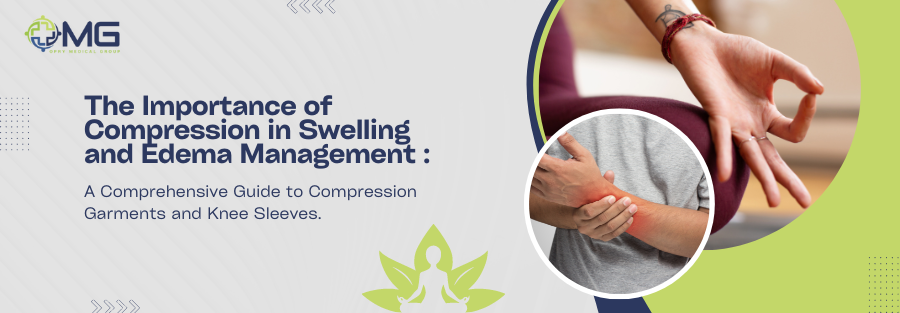Introduction:
Understanding the profound impact of compression on swelling and edema management becomes paramount. our comprehensive guide will help Explore the multifaceted significance of compression garments and knee sleeves, offering more than just relief from swelling. These dynamic elements play a crucial role in enhancing blood circulation, reducing muscle fatigue, and providing support for various conditions. Journey through their intricate design and therapeutic benefits—from post-exercise rejuvenation to injury prevention, discovering compression’s transformative power in promoting physical well-being and vitality.
The Significance of Compression
- Swelling and Edema Management: Compression is a key factor for the reduction of swelling and edema. The use of pressure helps with the management of fluid accumulation, resulting in relief and overall comfort, whether after an injury, during pregnancy, or because of a long-term condition.
- Enhanced Blood Circulation: One primary reason compression is significant is its ability to enhance blood circulation. Compression facilitates the venous return to muscles, enhancing performance and accelerating recovery by ensuring an uninterrupted flow of oxygenated blood into the muscle.
- Post-Exercise Recovery: Compression helps to speed up the recovery after intense physical activity. It helps to ease muscular pain, speed up the clearance of metabolic byproducts, and contributes to a quicker return to optimal function.
- Muscle Efficiency and Fatigue Reduction:Compression reduces muscle oscillation and fatigue, contributing to the muscle’s efficiency. It may increase stamina during physical activity and make it worth the effort for athletes and those engaged in regular exercise.
- Support for Specific Condition: Compression helps to speed up the recovery after intense physical activity. It helps to ease muscular pain, speed up the clearance of metabolic byproducts, and contributes to a quicker return to optimal function
Alleviating Swelling: The Compression Solution
Tackling Edema and Inflammation
- Postoperative Recovery: In postoperative scenarios, where swelling and inflammation are common, compression garments are crucial. They contribute to a faster recovery by managing postoperative edema and promoting healing in a controlled environment.
- Reduction of inflammatory Responses: Compression can modulate inflammatory responses by limiting the space available for swelling. This is particularly relevant in conditions where inflammation contributes to pain and discomfort, such as arthritis or post-injury recovery.
- Minimizing Discomfort: Swelling and inflammation often lead to discomfort and pain. Compression provides relief by minimizing the expansion of tissues, reducing pressure on nerves, and alleviating associated discomfort.
- Lymphatic Drainage Assistance: Edema often involves the retention of excess fluids. Compression sleeves aid in the movement of lymphatic fluid, enhancing drainage. This assists in the removal of fluid buildup and reduces swelling associated with conditions like lymphedema.
- Controlled pressure: Compression garments, including knee sleeves, apply controlled pressure to the affected area. This pressure helps to reduce the space available for swelling, preventing excessive fluid accumulation in the tissues.
The Dynamic Design of Knee Sleeves
Tailored for support
- Compression Zones: The design incorporates specific compression zones strategically placed to provide varying levels of pressure. These zones may target different parts of the knee, such as the patellar tendon or the joint space, offering customized support where it’s needed most.
- Anatomical Shape: Knee sleeves are crafted with an anatomical shape, mirroring the contours of the knee joint. This ensures a snug fit that doesn’t compromise comfort while offering optimal support to the patella, ligaments, and surrounding structures.
- Non-Slip Features: To ensure the sleeve stays in place during movement, many designs incorporate non-slip features such as silicone strips or patterns. This prevents constant readjustment and maintains consistent support throughout various activities.
- Reinforcement panels: Certain knee sleeves feature reinforcement panels made of durable materials like neoprene or elastic fibers. These panels enhance stability and provide extra support to vulnerable areas, such as the sides of the knee or the ligaments.
- Breathable Materials: Effective knee sleeve design includes using breathable materials to prevent overheating and discomfort. Ventilation is essential, especially during prolonged use or intense physical activity.
Navigating Venous return
- Strategic Compression Points: Knee sleeves are strategically engineered with compression points that align with major blood vessels and veins in the lower leg. By applying targeted pressure, these compression points aid in the efficient return of blood to the heart.
- Muscle Pump Activation: As the knee flexes and extends during movement, the dynamic design of knee sleeves activates the muscle pump mechanism. This rhythmic contraction and relaxation of muscles help propel blood against gravity, supporting venous return.
- Graduated Compression: The design incorporates graduated compression, meaning that the pressure exerted is highest at the extremities and gradually decreases toward the core. This mimics the natural flow of blood, assisting in venous return without impeding arterial circulation.
- Comfortable Compression: The dynamic design ensures that venous return is optimized without compromising comfort. The graduated compression is carefully calibrated to provide effective support while allowing unrestricted movement.
- Lymphatic Drainage Assistance: Venous return is closely tied to lymphatic drainage. Knee sleeves contribute to this process by applying gentle pressure that assists in the movement of lymph fluid, reducing swelling and maintaining a healthy fluid balance.
conclusion
the profound impact of compression on swelling and edema management transcends mere relief—it embodies a holistic approach to well-being. From navigating the venous return to lymphatic drainage assistance, compression garments, and knee sleeves prove to be dynamic solutions. Embrace their significance for postoperative recovery, injury prevention, and overall vitality. This comprehensive guide invites you to appreciate the transformative power of compression in fostering a healthier, more resilient lifestyle.



